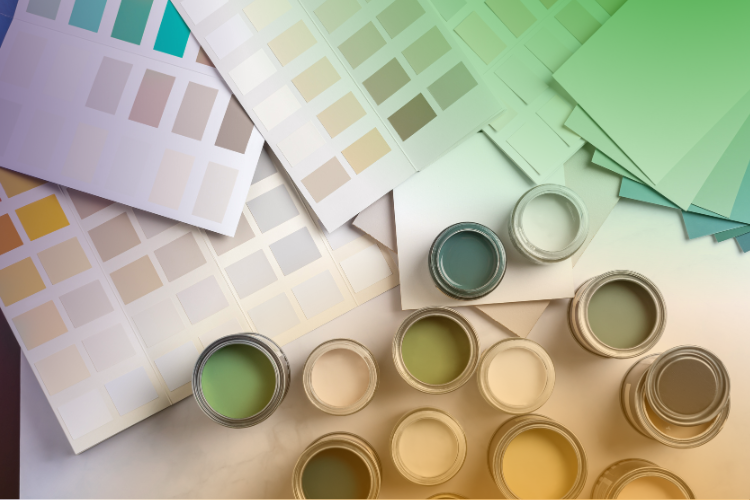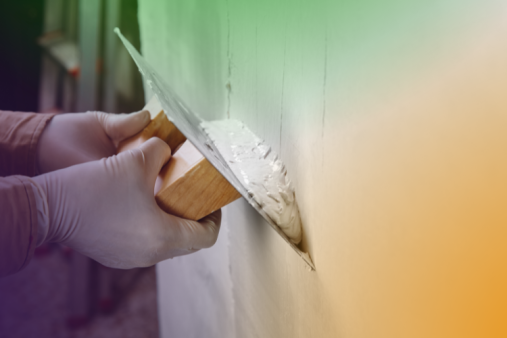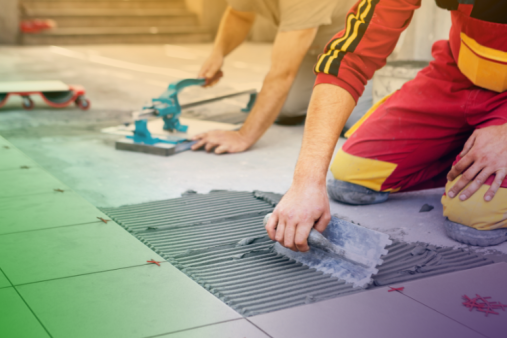In the world of painting and decorating, understanding the terminology is key to achieving professional results, whether you're a DIY enthusiast or a seasoned tradesperson. With countless techniques, tools, and materials at your disposal, navigating the jargon can sometimes feel overwhelming. That's why we've compiled an essential A-Z painting and decorating glossary.
This comprehensive guide covers over 100 terms, from 'Acrylic Paint' to 'Zinc-Rich Primer', providing clear and concise definitions to help you master the language of your craft. Whether you're prepping for your next big project, consulting with a professional, or simply aiming to expand your knowledge, our glossary is here to demystify the lingo and ensure you're equipped with the right information. Dive in and discover the terminology that will take your painting and decorating skills to the next level!
A
- Acrylic Paint: Water-based paint known for quick drying, flexibility, and durability.
- Adhesion: The ability of a paint or primer to stick to a surface.
- Airless Sprayer: A device that pumps paint at high pressure to atomize it into a spray without using compressed air.
- Alkyd Paint: Oil-based paint known for its durability and smooth finish.
- Alligatoring: A paint film defect characterized by a pattern of cracks resembling an alligator's skin.
- Anti-Slip Paint: Paint designed to reduce slipperiness on surfaces like floors and stairs.
- Apprenticeship: Training program combining on-the-job training with classroom instruction for new decorators.
B
- Back Rolling: Rolling a surface after spraying to ensure even application and better adhesion.
- Binder: The component in paint that holds the pigment together and adheres it to the surface.
- Blistering: The formation of bubbles in the paint film due to heat, moisture, or incompatible coatings.
- Block Primer: Primer designed to block stains and prevent them from bleeding through the topcoat.
- Blooming: A whitish haze on the paint surface caused by moisture or incompatible materials.
- Brush Mark: Visible lines left by a brush during paint application.
- Burnishing: The appearance of shiny spots on a painted surface due to excessive scrubbing or rubbing.
C
- Caulk: A flexible material used to fill gaps and cracks before painting.
- Chalking: The formation of a powdery residue on the surface of paint due to weathering.
- Colour Fastness: The ability of paint to retain its original colour without fading or discolouring.
- Colour Wash: A decorative technique where a translucent layer of paint is applied over a base coat.
- Combing: A faux finishing technique that creates a textured, lined effect with a comb-like tool.
- Cutting In: Painting the edges and corners of a wall or trim before rolling the main surface.
- Cracking: Splits in the paint film due to improper application or substrate movement.
D
- Drop Cloth: Protective covering used to catch drips and spills during painting.
- Damp-Proof Paint: Paint formulated to prevent dampness and moisture from penetrating surfaces.
- Deglossing: The process of reducing the shine of a surface to improve paint adhesion.
- Decorative Finishes: Techniques used to create special textures or effects, such as sponging or rag rolling.
- Dry Brushing: A technique where a dry brush is used to apply paint lightly, creating a textured effect.
- Dripless Caulk Gun: A caulking gun designed to stop dispensing caulk when the trigger is released.
E
- Eggshell Finish: A paint finish that has a slight sheen, resembling the surface of an eggshell.
- Emulsion Paint: Water-based paint commonly used for walls and ceilings, known for its ease of application and cleanup.
- Epoxy Paint: A durable, chemical-resistant paint often used for floors and industrial surfaces.
- Etching: Preparing a surface for painting by using an acid to roughen it and improve adhesion.
- Exterior Paint: Paint specifically formulated to withstand outdoor conditions.
F
- Faux Finish: Decorative painting techniques that mimic the appearance of other materials, such as marble or wood.
- Feathering: Blending paint edges to create a smooth transition between colours or areas.
- Filbert Brush: A brush with an oval-shaped tip, useful for detail work and blending.
- Flaking: Paint lifting and peeling away from the surface due to poor adhesion or substrate issues.
- Flat Finish: A non-reflective paint finish that hides surface imperfections.
- Flashing: Uneven glossiness or colour variation caused by improper application or surface preparation.
- Flow Additive: A substance added to paint to improve its flow and leveling properties.
G
- Gloss Finish: A highly reflective paint finish that is durable and easy to clean.
- Graining: A faux finish technique that imitates the look of wood grain.
- Ground Coat: The base coat of paint applied before a decorative finish.
- Grit: The coarseness of sandpaper, used to smooth surfaces before painting.
H
- High-Build Paint: Paint that can be applied in thick layers to provide better coverage and fill minor surface imperfections.
- High-Gloss Finish: A very shiny, reflective paint finish that is extremely durable.
- HVLH Sprayer: High Volume Low Pressure sprayer that reduces overspray and provides a fine finish.
- Hydro Blasting: A cleaning method using high-pressure water to prepare surfaces for painting.
I
- Impact-Resistant Paint: Paint formulated to withstand physical impacts and abrasions.
- Industrial Coatings: Paints designed for heavy-duty use in industrial environments.
- Interior Paint: Paint specifically formulated for indoor use, with low VOCs and appropriate finish options.
- Isolating Primer: Primer used to isolate and cover stains or previous coatings that may bleed through.
J
- J-Channel: A trim piece used in siding installations, often painted to match the surrounding area.
K
- Keying: Roughening a surface to improve paint adhesion.
- Knotting Solution: A solution applied to wood knots to prevent resin from bleeding through paint.
L
- Latex Paint: Another term for water-based paint, known for its ease of use and quick drying time.
- Levelling: The ability of paint to spread out evenly over a surface.
- Limewash: A traditional paint made from lime and water, offering a unique matte finish.
- Low-VOC Paint: Paint with reduced volatile organic compounds, making it more environmentally friendly.
M
- Masonry Paint: Paint designed specifically for application on brick, stone, and other masonry surfaces.
- Matte Finish: A flat, non-reflective paint finish that hides imperfections.
- MDF (Medium Density Fibreboard): A type of engineered wood often painted or decorated.
- Milk Paint: A non-toxic paint made from natural ingredients, providing a vintage look.
- Mineral Spirits: A solvent used for thinning oil-based paints and cleaning brushes.
- Mist Coat: A diluted coat of paint applied as a primer on new plaster or drywall.
N
- Nap: The length of fibres on a roller, affecting the texture of the paint finish.
- Neutral Colour: Colours like beige, grey, and white, often used as a base or backdrop in decorating.
- Non-Drip Paint: Thicker paint that doesn't run, making it easier to apply on vertical surfaces.
O
- Oil-Based Paint: Paint that uses oil as a binder, known for its durability and smooth finish.
- Opacity: The ability of paint to hide the surface underneath it.
- Overbrushing: Applying too much pressure with a brush, leading to streaks and uneven texture.
- Oxidation: The chemical reaction that causes paint to dry and harden.
P
- Paint Additive: Substances added to paint to modify its properties, such as drying time or texture.
- Paint Pad: A flat, rectangular tool used to apply paint, particularly useful for edges and corners.
- Palette Knife: A tool used for mixing paint or creating texture in decorative finishes.
- Patch Primer: Primer applied to specific areas that need extra adhesion or sealing.
- Peeling: When paint comes away from the surface in sheets or flakes.
- Pigment: The component in paint that provides colour.
- Polyurethane: A clear, durable finish applied over paint or wood surfaces for protection.
- Pot Life: The amount of time a mixed paint or coating remains usable.
- Primer: An undercoat applied to prepare the surface for the topcoat, improving adhesion and durability.
- PVA (Polyvinyl Acetate): A type of primer or adhesive used for sealing porous surfaces.
Q
- Quick-Dry Paint: Paint formulated to dry faster than standard paints.
R
- Rag Rolling: A decorative painting technique using a rag to create a textured effect.
- Recoat Time: The recommended waiting period before applying a subsequent coat of paint.
- Roller Cover: The fabric sleeve on a paint roller, available in various naps for different finishes.
- Run: Drips or sags in the paint film due to excessive application.
- Rust Inhibitor: A primer or paint additive that prevents metal surfaces from rusting.
S
- Satin Finish: A paint finish with a soft sheen, providing a balance between matte and gloss.
- Scumble Glaze: A translucent coating applied over a base coat to create a weathered look.
- Shellac: A natural resin used as a sealer and primer for various surfaces.
- Sheen: The level of glossiness in a paint finish.
- Silicone Sealant: A flexible, waterproof sealant used around windows, doors, and other joints.
- Skim Coating: Applying a thin layer of plaster or joint compound to smooth a surface.
- Spackle: A filler used to repair small holes and cracks in walls before painting.
- Stippling: A technique using a brush or roller to create a textured effect by tapping the surface.
- Stripper: A chemical product used to remove old paint or varnish.
T
- Tack Cloth: A sticky cloth used to remove dust and debris before painting.
- Taping: Applying tape to protect areas from paint or to create clean lines.
- Textured Paint: Paint that contains additives to create a textured finish.
- Tint: Adding colourant to paint to achieve a desired shade.
- Touch-Up: Minor painting to correct blemishes or damage after the main application.
- Turpentine: A solvent used for thinning oil-based paints and cleaning brushes.
U
- Undercoat: A layer of paint applied before the topcoat, often synonymous with primer.
- UV Resistant: Paint formulated to withstand damage from ultraviolet light.
V
- Varnish: A transparent, protective finish applied over paint or wood.
- VOCs (Volatile Organic Compounds): Harmful chemicals that can be emitted from paint, affecting air quality.
W
- Washable Paint: Paint that can be easily cleaned without damaging the finish.
- Water-Based Paint: Paint that uses water as a solvent, known for low odour and quick drying.
- Weatherproofing: Coatings designed to protect surfaces from weather damage.
- Wood Stain: A product that penetrates wood to enhance its natural colour and grain.
X
- Xylene: A solvent used in some paint and varnish formulations.
Y
- Yellowing: Discolouration of paint over time, typically in oil-based paints.
Z
- Zinc-Rich Primer: A primer containing zinc, used to protect metal from corrosion.


